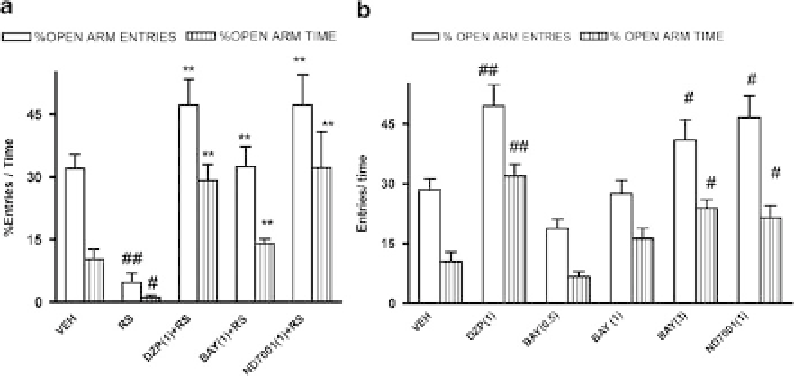Biology Reference
In-Depth Information
Fig. 1 Effects of the PDE2 inhibitors Bay 60-7550 (BAY) and ND7001 on behavior in the
elevated plus-maze in stressed (a) and nonstressed (b) mice. Increases in percentages open-arm
entries and time indicate an anxiolytic effect, whereas decreases in these measures indicate an
anxiogenic effect. Values are expressed as mean
#
p
0.05 and
##
p
SEM. (
n
¼
6-8).
0.01
<
<
**
p
compared with vehicle (VEH).
0.01 compared with restraint stress (RS).
DZP
diazepam.
Doses shown parenthetically are milligrams per kilogram i.p. Reprinted with permission from
(Masood et al.
2009
)
<
3.3 PDE3
PDE3 was originally characterized by its high affinity for both cAMP and cGMP,
but subsequent in vivo studies suggested that the hydrolysis of cAMP is inhibited by
cGMP. This finding is supported by the data from intact cells containing PDE3
(Maurice and Haslam
1990
). Two PDE3 isoforms, PDE3A and PDE3B, have
different subcellular locations due to their different N-terminal regions, but have
similar kinetic properties since they have amino acid identity over their catalytic
sites (Bender and Beavo
2006
; Pyne et al.
1986
). The activity of PDE3 is modulated
in several cell types by phosphorylation in response to hormonal stimulation by
prostaglandins, epinephrine, and insulin (Murata et al.
2009
;ZaccoloandMovsesian
2007
; Thompson et al.
2007
; Palmer et al.
2007
). PDE3 specific inhibitors including
amrinone, trequinsin, and cilostazol, have been identified, but they do not distin-
guish between PDE3A and PDE3B (Thompson et al.
2007
).
PDE3 inhibitor effects are related to preventing platelet aggregation and regu-
lating myocardial contractility and smooth muscular vasodilation. One of the
inhibitors, cilostazol, is reported to increase insulin-like growth factor I (IGF-I)
and cAMP levels in the hippocampus (Zhao et al.
2010
). It is speculated that
this results in stimulation of sensory neurons resulting in improved cognitive
function in mice (Zhao et al.
2010
). Further studies are needed to confirm the
effects of PDE3 inhibitors in the CNS, particularly in the modulation of learning
and memory.

